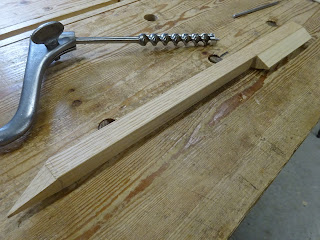So I've got the seat, legs and arm/back support sticks prepared. The next part to make was the arm bow. I figured I'd do a prototype to work out the kinks. With a prototype I can use mismatched and totally unsuitable woods. This arm bow is made up of three pieces (eventually it was five pieces). The middle piece is a 1 5/8" thick chunk of redwood and the rest is 3/4" red oak laminated to make pieces wide enough. The parts are joined using barefaced tenons on the redwood piece and the oak is glued to that, kind of like a lap joint.
 |
| Redwood sitting on the arm bow template with two angled ends |
 |
| The ends have had a 3/4" thick section removed underneath |
 |
| The oak was glued into the removed section (big rabbet?), creating that lap joint |
 |
| Here's the (mostly) shaped arm bow |
 |
| And here it is roughly in place, positioned using the arm bow drilling jigs |
Unfortunately, it seemed like the arm bow was way too short. It started out 10" along a centerline from the inside curve at the back to the tips of the arms. I half-lapped on another 3" piece to make the arms 13" deep.
 |
| An extension piece on each end added 3" to the arms (shown before shaping) |
The next step was to figure out how to bore the holes through the arm bow, in a direct line to where the holes in the seat need to go. I had laid out the hole location in both the arm bow and the seat. The key to getting the chair together is to get the arm bow holes to line up with the seat holes. I noodled about this for quite a while and tried a few things before I got it right.
 |
| First idea: using a straight stick from seat to arm bow to align the auger bit to. The right side of this stick (where my finger is pointing) is aligned with the arm bow hole and seat hole locations. |
Using this method, I had to place the bottom of the stick a distance forward of the seat hole location that was the same as the distance from the arm bow hole location to the front of the arm bow (about 1 1/4").
 |
| Boring a hole in the arm bow, lining the bit up with the stick |
 |
| I also had a mirror on the workbench giving me a view from a right angle to see if my bit was lined up with the stick |
But this method left too much to chance, as evidenced by the arm bow holes not coming close enough to being in alignment with the seat hole locations.
My next idea was to use a special stick with one end pointed so it could sit in a small hole (made with an awl) at the seat-hole location. The upper end of the stick had a glued-on extension to help point the auger bit. This also wasn't quite right.
 |
| This stick has a point in line with one side and an a triangle-shaped extension at the top end |
 |
| Here's another method I tried. I'm trying to line up the holes in arm bow and seat using a ruler and square. This also wasn't the answer. |
With this stick, the upper extension can rest against a 5/8" auger bit, bringing the bit in better alignment with the seat hole location. The width of the two extensions was large enough for the stick to clear the arm bow when in use.
 |
| The stick in use. It's not easy to see in this picture, but the bottom of the stick has a point sitting in a tiny hole at the seat hole location. |
 |
| Note that the auger bit has to align well with the edge of the upper part of the stick |
Finally I was getting holes bored in the correct alignment! Most of the arm bow holes were bored before getting this stick right, so they're not aligned properly. This arm bow was a prototype, so I'll be making another, and that'll be in another post.


No comments:
Post a Comment